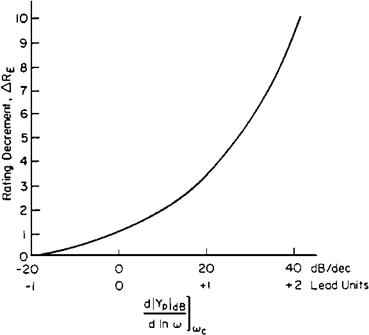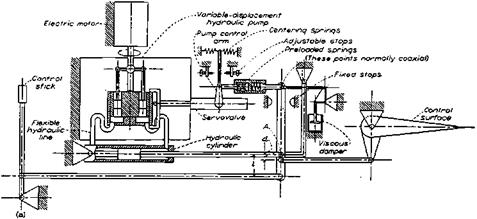The first stability augmenters appeared during World War II. Little detailed information is available about them. A German Blohm and Voss Bv 222 flying boat was thought to have had a pitch damper acting through a small, separate elevator surface. In a paper delivered in 1947, M. B. Morgan described an experimental yaw damper installed on a Gloster Meteor jet airplane. Other notable early designs were the Boeing B-47 and the Northrop YB-49 yaw dampers and the Northrop F-89 sideslip stability augmenter, which are discussed below.
20.5.1 The Boeing B-47 Yaw Damper
The B-47 Stratojet was a radical airplane in its time, a six-jet bomber with very flexible sweptback wings. Early flight tests disclosed that damping in yaw at low airspeeds was much less than pilots could deal with in landing approaches. The main pilot objection was to the rolling portion of the motion, caused by the dihedral effect of the swept wings at high angles of attack. After discarding other alternatives, Boeing engineers decided to attack the rolling motion indirectly, by artificial yaw damping using a rate gyro and the airplane’s rudder. That is, by suppressing side-slipping motions, the airplane’s rolling moment due to sideslip would not cause the objectionable wallowing in landing approaches.
The engineers who were chiefly responsible for the XB-47 yaw damper design were William H. Cook and Edward Pfafman. Roland J. White, who made a frequency-response analysis of the XB-47 yaw damper design, provides a complete account of the development (White, 1950). In White’s account one can find all of the elements that go into modern stability augmenter designs, even though in unfamiliar form in some cases. These are
the application of servomechanism analysis, using the equations of airplane motion;
airframe mathematical model includes aeroelastic bending effects; irreversible power controls;
stability augmentation series servo, isolating the pilot from the servo action; artificial feel system.
Roland White’s XB-47 yaw damper servomechanism analysis, using inverse frequency response, was advanced for its time. However, the all-important matter of loop gain, or commanded rudder angle per unit yaw rate, was apparently settled in flight test. William Cook remembers that Robert Robbins, the XB-47 test pilot, had a rheostat that varied yaw damper gain, and that Robbins chose the value that seemed to work best.
With no fund of stability augmenter design information to draw upon, Cook and Pfafman improvised the yaw damper both in terms of design requirements and hardware. A short phone call from Cook at the Moses Lake flight test site to Pfafman laid out the key design requirements of rudder damping authority (one-fourth of full travel) and series actuation. The yaw damper servo was an electric motor and amplifier that had been used for B-29 turbo-supercharger waste gate control (Figure 20.1).
White’s paper was delivered at the Design Session of the Institute of the Aeronautical Sciences 1949 Annual Summer Meeting in Los Angeles. The concept of stability augmentation as a normal design feature for swept-wing airplanes had not yet been established, and White’s paper irritated at least one purist. According to Duane McRuer, this person, a respected professor of design at Cal Tech, got off the following comment during the paper’s discussion period:
If the B-47 had been designed properly, it would not have needed electronic stability augmentation.
William H. Cook (1991) reports a similar reaction from an MIT professor, unhappy that an “artificial” solution had been used on the B-47 to solve an aerodynamic stability problem. Of course, there is a perfectly sound aerodynamic reason why yaw stability augmentation is needed on jet airplanes and is not an evidence of poor design. Approximately, Dutch roll damping ratio is directly proportional to atmospheric density. An airplane with a satisfactory damping ratio of 0.3 at sea level will have a damping ratio of only 0.06 at an altitude of 45,000 feet.












